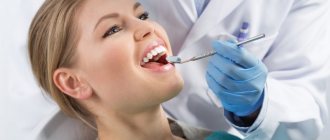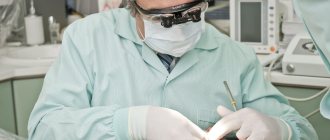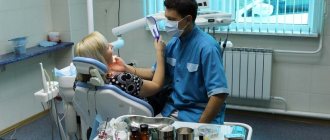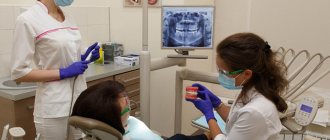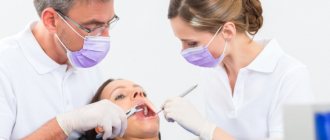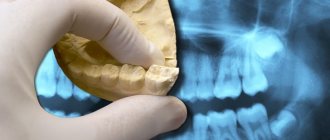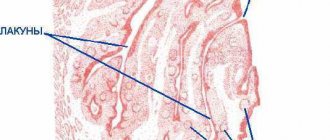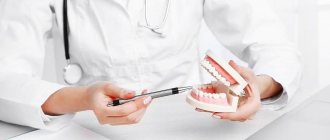Orthodontics is one of the most complex dental specialties. There is no clear understanding of the importance of correcting the bite in the context of comprehensive dental rehabilitation, even among doctors - what can we say about the unity of approaches, methods and opinions? Orthodontics is a mystery, especially for the older generation of dentists, because thirty to forty years ago no one thought about the influence of bite on the condition and health of the dental system.
And how many myths and misconceptions about orthodontic treatment circulate among patients! Here there are terms of five years, and caries under braces, and the fact that “it’s too late to correct something at 25 years old,” and much more...
Anna Sotnikova, an orthodontist at CLINIC IN, a specialist in bite correction and just a good person, like our entire team, believes that the more you know about orthodontics, the better for everyone.
Therefore, I decided to tell you, dear friends, what you need to know about correcting your bite even before you come to her for a consultation.
So, the first thing you need to know about bite:
Correct bite is the basis for a healthy dental system.
It is impossible to carry out full dental rehabilitation without correcting the bite in some way. In addition, the state of the bite, the nature of the closure of the teeth, load distribution, etc., are taken into account even in the treatment of caries, implantation, in periodontics, not to mention prosthetics. The condition of your bite is a feature of yours that is taken into account by the doctor when selecting a plan for individual oral hygiene and other preventive measures. Ignoring this fact leads to a huge number of problems and medical errors that sadly affect the results of treatment.
The second thing you need to know about bite:
A beautiful smile does not always mean a correct bite. And vice versa.
When we, doctors, talk about “correct bite,” we usually mean a position of the teeth in which they evenly and correctly distribute the chewing load. In other words, when correcting a bite, we primarily focus on function. Aesthetics, in fact, is a by-product of functional correction.
As aviators say: “An ugly plane doesn’t fly.” It’s the same with us orthodontists – a fully functional bite cannot but be beautiful.
Third, no less important:
Whatever the technique for changing the bite, it is based on the same, simple and understandable physiological mechanisms.
This means that all existing orthodontic methods have more or less similar effectiveness and treatment time. Of course, subject to the correct selection in a certain clinical situation. But we will tell you about this a little later.
And finally, fourth:
Bite is a dynamic thing and changes with age.
It is affected by literally everything: fillings, crowns, missing teeth, wisdom teeth, bad habits, etc. Yes, what can we say - even with the ideal condition of the teeth, their wear and tear will lead to changes over time. In this regard, the key point of orthodontics is to make age-related changes in the bite so insignificant that they do not lead to any complications or deterioration in the quality of life .
And for this you need to know the patterns of development of this or that dental pathology and its relationship with the state of the bite.
What does an orthodontist treat in children?
The list of orthodontic diseases, pathologies and anomalies is extensive. These are not only bite defects, but also many other deviations - congenital, hereditary, acquired. The most common problems people come to dentistry for are:
- teeth;
- dentofacial rows;
- bite
Pathologies and dental anomalies
When assessing individual units of a child’s jaws, a pediatric dentist or orthodontist will pay attention to the developmental features of each individual tooth:
- shape - classic or spiky, screwdriver-shaped, barrel-shaped, with deformations of the cutting edge line;
- dimensions - reduced or increased compared to neighboring units;
- tissue structure - normal teeth, underdeveloped condition, excess tissue volume;
- timing of appearance - according to the age of the child, early eruption or late;
- position in the jaw row - rotated, tooth growth from the side of the lip or from the side of the palate, excessive protrusion from the gums, growth in place of another tooth.
Also, the pediatric orthodontist will note the number of teeth in a row - edentulism or the presence of supernumerary teeth.
Almost all of the problems listed are solvable. Modern dental methods can quickly and painlessly change the positions of teeth, reverse pathologically located units, help quickly remove excess teeth and perform prosthetics in the absence.
Anomalies of the dentition
What does the pediatric orthodontist treat in this case? Problems of the dentition are more serious for dental health than single anomalies of growing units. Incorrect position of the jaws affects the quality of speech, creates difficulties in nutrition, and worsens the aesthetics of the face.
The most common problems relate to:
- The size of the jaw rows is excessive growth of one of the jaws compared to the second or a delay in development in both rows.
- The position of the jaw relative to the base of the skull is asymmetry, forward or backward displacement.
- Consistency and symmetry of the arrangement of teeth - poor contact when closing, crowding, rare position, large gaps between units.
Anomalies of bite, occlusion
Pathological bite is the most common problem among young patients. The orthodontist will successfully correct the bite
- distal - the upper dental row is highly developed and protrudes forward;
- mesial - excessive development of the lower jaw is observed;
- cross - when the teeth are closed, the upper dental row intersects with the lower one;
- deep - the upper incisors completely cover the lower ones;
- open - the teeth are only partially connected.
There are many pathologies, and the doctor’s task is to make the correct diagnosis and select the correct treatment.
Causes of incorrect formation of children's bite
The following factors lead to malocclusion in children:
- sucking pacifiers;
- long-term breastfeeding (more than 1.5 years);
- tooth decay;
- the predominance of liquid food in the diet;
- inflammation of the gums;
- habits of sucking fingers, biting pencils or nails;
- late eruption;
- broken bite in relatives.
The type of malocclusion is determined by the position of the rows of teeth relative to each other with the jaws closed. The following pathologies in children are distinguished:
- Distal bite – the upper jaw is pushed forward.
- Mesial – the lower jaw protrudes forward
- Open – the front teeth do not meet when the mouth is closed.
- Deep - the upper teeth are significantly lowered down, overlapping the lower teeth by more than half.
- Crossed – teeth meet unevenly.
- Dystopia – teeth do not grow along the growth line.
- Diastema – thinning of teeth, increasing gaps.
Diagnosis of orthodontic diseases
It is important for a pediatric orthodontist to see a comprehensive picture - not only the current state of the oral cavity, but also the rudiments of future teeth and the structure of bone tissue. To do this, the dentist chooses several diagnostic methods:
- Orthopantomography (OPTG) is an x-ray of the bones of the facial skeleton when all the teeth are aligned in one line.
- Teleroentgenogram (TRG) is an x-ray of the jaw in the frontal and lateral projections of the skull.
- Casts are real-size simulations of the jaw to evaluate the position, shape and size of individual teeth.
- Photographing of the face and oral cavity to assess asymmetry, external deformations, and carry out calculations.
- Computed tomography (CT) is a three-dimensional image of the jaw in digital format.
- Video recording - recording abnormal manifestations of jaw function in dynamics.
Also, a pediatric orthodontist may refer the patient for a consultation with dentists or doctors of other specializations to obtain an additional professional opinion.
Consequences of malocclusion
An uncorrected bite brings aesthetic inconvenience to a person: he cannot smile openly and widely, his face is asymmetrical, some parts sink in or, on the contrary, protrude forward..
Moreover, an incorrect bite can cause problems with diction, as a result of which full communication will be impossible.
Consequences also include:
- excessive abrasion of tooth enamel and its sensitivity;
- its susceptibility to severe caries;
- problems with gums, jaw bones;
- early tooth loss;
- deformation of the lower part of the face;
- breathing problems up to stopping during sleep (apnea), frequent ENT diseases and respiratory viral infections;
- constant headaches;
- formation of ulcers in the oral cavity due to permanent traumatic damage to soft tissues;
- problems with the gastrointestinal tract due to insufficient or improper chewing of food, improper swallowing.
In the future, ignoring timely treatment can lead to complicated and expensive installation of dentures.
Pediatric dentistry: how an orthodontist treats
A pediatric orthodontist chooses a treatment method only after a complete examination of the patient. When making a decision, the doctor takes into account:
- child's age;
- type of bite - milk, permanent, replaceable;
- orthodontic pathology - anomalies of teeth, dentition, bite.
The most popular correction methods:
- myogymnastics (myotherapy) - a course of special exercises aimed at strengthening the muscles of the maxillofacial area;
- surgical method - necessary to eliminate pronounced deformations of the bite, jaw rows, dental sequences;
- hardware therapy - the use of fixed and removable structures to correct the bite or individual units.
Prevention
It is possible to prevent malocclusion by correcting risk factors associated with behavior; Hereditary predisposition cannot be influenced. Prevention methods:
- During pregnancy, the expectant mother should eat enough foods containing calcium;
- visit a pediatric dentist from the moment the first teeth appear and then at least once a year;
- If possible, breastfeed your baby, avoiding the nipple;
- if the baby is breastfed, then use nipples with a small hole to stimulate sucking;
- Introduce solid foods into the diet in a timely manner.
Important! Parents with malocclusion in children need to start paying attention to preventing the formation of incorrect position of children's jaws as early as possible. Regular myogymnastics classes, as well as all of the above methods, are suitable for this.
Correcting teeth in children is an important task, the timely solution of which will prevent the development of many problems, both physiological and psychological. The doctor chooses the most appropriate method for correcting the bite; control of treatment lies with the parents.
Author: Zhukov M.A.
Orthodontic devices for bite treatment
Orthodontic systems are created or customized to address a patient's specific problems. When installed on the teeth, the corrective system begins to put pressure on abnormally located areas, forcing:
- teeth move into the correct position;
- dental rows expand to anatomically correct sizes;
- muscles tighten, returning them activity and strength.
When choosing a device for treatment, an experienced orthodontist will take into account the absence of certain restrictions. Correction of anomalies is possible in the following cases:
- the teeth experience sufficient pressure to move into the desired position;
- the orthodontic apparatus is well fixed and supported;
- the dentofacial row is prepared - there is a place where the tooth that can be moved or rotated will fit;
- the tooth being moved has no obstacles to movement.
The main structures for correcting malocclusion used by an orthodontist:
- plates are mainly removable systems that help move teeth and expand the jaw to the desired size;
- trainers - silicone products for high-quality fixation of the position of the tongue and teeth, helping the teeth of the permanent bite to grow correctly and solving a number of other orthodontic problems;
- aligners are individually created aligners that are invisible on the teeth and can quickly move incorrectly positioned teeth to anatomically correct points;
- braces are non-removable orthodontic systems for high-quality correction of any malocclusion.
Rodikova Tatyana
Today, braces and aligners are competitors. Many parents ask for aligners for their children, since they are practically invisible on the teeth. Unfortunately, aligners do not cope with all malocclusions, but if possible, then, of course, I will agree with the patient’s wishes.
How can I correct my bite?
In the arsenal of a modern orthodontist there are several tools for correcting bites, which can be divided into two large groups: removable and fixed orthodontic appliances.
Removable ones are all kinds of plates, mouth guards, trainers, etc. They are mainly used in childhood.
Fixed orthodontic devices include not only well-known braces, but also special designs, for example, for jaw expansion, supporting orthodontic mini-implants, etc.
We will talk to you in more detail about indications/contraindications, pros/cons and features of various methods of correcting bites next time. In the meantime, you need to know that subject to proper diagnosis, planning, and selection of an orthodontic appliance (depending on the clinical situation and a number of other factors)
All orthodontic treatment methods are equally effective.
If only because they work according to the same physiological principles.
Indications for contacting an orthodontist
A visit to the orthodontist should be scheduled after the primary baby teeth appear—at 3-4 years of age. An early examination will help to identify pathology at the stage of formation of the dental system of a young patient, which will significantly facilitate and speed up treatment.
You should also schedule a mandatory visit to the orthodontist if you have:
- bad habits in a child - he will not part with the pacifier, constantly holds his thumb in his mouth, chews pencils and pens;
- mouth breathing - reluctance to breathe through the nose indicates orthodontic pathologies;
- obvious deviations in the development of the dentofacial apparatus - congenital or appearing as teeth grow or change;
- difficulties in swallowing, chewing;
- speech therapy problems, difficulties in pronouncing individual sounds;
- large interdental spaces;
- crowding.
When do you need orthodontic help?
People tend to believe that bites are corrected only in childhood and adolescence. This is wrong. You can (and should) correct your bite at any age. Only at an older age the process will take longer. This is due to the fact that the bone density of an adult is much higher.
It is not the aesthetic appearance of your teeth that should push you to visit an orthodontist. If the doctor gave you a favorable prognosis, try to listen to him and follow the recommendations. But the final decision on correction will still be yours.
The next reason for a mandatory visit is disturbances in the functioning of the entire dental system. Basically, this is serious damage to the gums and difficulty in installing prosthetics.
If a patient has crowded teeth, the orthodontist will use the site of the missing tooth to correct the defect. A timely visit to the orthodontist will help you avoid the procedure of prosthetics altogether.
Orthodontic intervention will be required if the teeth themselves are incorrectly inclined towards the site of the extracted tooth, and the patient requires prosthetics. In this case, it is impossible to make high-quality prosthetics without the intervention of an orthodontist.
A dental occlusion doctor will help solve the problem for both small and large patients. The doctor will correct the bite:
- with not the first deformations;
- when the bite deepens;
- during teething, which occurs constantly;
- with a fairly close arrangement;
- for deformations as a result of periodontal diseases;
- with loss of teeth.
The sooner parents notice abnormalities in the development of teeth and contact an orthodontist, the better. Firstly, the child will soon have teeth without defects. Secondly, as an adult, he will not need such treatment (the process of correcting the bite will be faster and easier). Thirdly, a person will walk around with a beautiful mouth for most of his life.
For teenagers and adults, the doctor usually installs non-removable devices - braces. There are several options for braces: traditional metal and modern self-regulating.
How to prepare your child for an orthodontic appointment
The initial appointment with an orthodontist takes place without any preparation. The child just needs to brush his teeth and eat beforehand. The latter is desirable, as it will help reduce salivation and facilitate the examination procedure. The child should also be told about the doctor’s specialization. In simple words, explain who this pediatric orthodontist is and what he treats.
An orthodontic examination is a painless procedure. It does not cause fear or discomfort in the baby, but it helps to identify deviations in the development of the dentition as early as possible.
Soldatenkova Alina
For fearful children, our clinic provides adaptation techniques. Such meetings help to get acquainted with the dental center and learn in a playful way about the work of dentists. The initial appointment can be combined with adaptation and an examination of the teeth and mouth can be carried out unnoticed by the child.
Anomalies of teeth
An incorrect bite can occur due to the following anomalies:
- anomalies of both individual teeth and several (for example, teeth are rotated, tilted, erupt in the wrong place, or the patient simply has supernumerary teeth);
- abnormalities of the jaws (for example, backward displacement of the jaw, protrusion and insufficient development);
- anomalies of the dentition (for example, the inclination of several teeth towards the tongue and in the opposite direction, gaps between them or, conversely, a crowded arrangement).
Description of structures used to correct bite
1. Aligners (or mouth guards). They are made from very durable materials.
Aligners have a number of advantages:
- the structure is removed;
- they are invisible to the eye, as they are made of transparent material;
- discomfort from the aligners is minimal;
- the devices do not require specialized care. You just need to maintain hygiene by rinsing the trays with water.
2. Trainers. These structures are manufactured in series. In this regard, these devices are available to almost all groups of the population. The devices themselves are worn only a few hours a day. The wearing time depends on the doctor's prescription. Trainers are used by orthodontists to correct minor bite deformities. The peculiarity of using the devices is that they allow you to straighten teeth that are located separately from each other.
3. Braces are brackets connected by a power arc. Braces are attached to the teeth, fixing the desired position. The braces correction method is universal, as it copes with many deviations. Period of wearing braces: from 2 months to 5 years. The period of straightening depends on how crooked the teeth were at the very beginning and how the body adapts to the changes made.
How much does orthognathic surgery cost in Krasnodar?
The cost of the operation includes the operation itself and the post-operative period.
Orthognathic surgery without a postoperative period costs about 200 thousand rubles. The postoperative period will cost about 100 thousand rubles.
Patients in most cases are satisfied with the surgical intervention. They note an improvement in their quality of life. But for some, the disadvantage of this type of operation is the high cost. Since this type of operation is a planned operation of moderate severity, it is possible to carry it out under compulsory medical insurance. The waiting period can be more than 6 months.
Features of the orthodontist's work
The doctor sees at least two people per hour. In a day, it turns out that he needs to treat and consult 12-13 people. During this time, the doctor should discuss the problem with the patient, listen to complaints and talk about his suggestions. The doctor will try to convey to the patient why it is necessary to wear braces and how the bite will change over time.
Its treatment comes down to two stages of exposure. At the first stage, he makes diagnostics and installs corrective devices. On the second, the result that was obtained is secured with the help of retainers or trainers (mouth guards). They are placed on the inside of the tooth to prevent the bite from shifting.
It is very important for an orthodontist to choose the right device. The designs of the devices differ in appearance, principle of influence and methods of fastening.
During treatment, the doctor encounters different types of bites:
- Hereditary. The bite is passed on to children from their parents. In addition to malocclusion, the patient has additional teeth, trema and diastema. Additional procedures will be needed to diagnose this species.
- Congenital. The species is directly related to abnormal development of the fetus. After birth, at an older age, a person’s milk and permanent teeth have an irregular shape. Their partial or complete absence is also observed. This is a fairly complex type, but an experienced and qualified orthodontist will be able to solve the problem.
- Acquired. This type of bite defect appears several years after birth. Its treatment is faster and more effective than other malocclusions, because such malocclusion can be detected in the early stages.
Modern people are lucky. Today, there is an orthodontist in many city hospitals and private clinics. You can visit a doctor either for free or for money. A qualified specialist will help correct dental defects and give them an aesthetic appearance.
An orthodontist who has established himself as a good specialist is usually rich in a number of human qualities and professional skills. The beauty, convenience and appearance of teeth depends on his work. He is not your average dentist that we visit multiple times. Therefore, it is very important that friendly contact is immediately established between the doctor and the patient.
What are these human qualities of an orthodontist? These are, first of all, tolerance, sociability and diligence. In addition, the doctor must have a good understanding of the psychological aspects of his work. Most people don't feel good about braces. Unsightly plaques in their mouth cause them stress. Therefore, it is very important to win over the patient from the first minute.
Who is a gnathologist?
A gnathologist is a specialist who deals with dysfunctions of the temporomandibular joint (TMJ)
Unfortunately, it is almost impossible to treat TMJ with medication or physical therapy; there is no magic ointment or pill to stop the pain, so most often the conversation is about the bite and closing of the teeth.
Here we get to the most important thing - how are some kind of joint and teeth connected?
A little anatomy. Our lower jaw actually exists separately from the skull and the whole body, connected to the skull only by “soft” structures, such as muscles, ligaments and other connective tissues.
And the only “rigid” position of the lower jaw and TMJ is the state when the teeth are closed.
It is important to know that almost 90% of people have one or another pathology of teeth closure: crowding, absence of one or more teeth, abrasion, not to mention global dysgnathias.
You should contact a gnathologist for a number of reasons. The first group refers to cases when something is clearly bothering you.
Here is a standard list of reasons that may be associated with gnathology.
- Pain directly in the TMJ area
- Pain in the masticatory muscles
- Difficulty moving the lower jaw, in particular limited opening and closing of the jaws
- Sounds in the joint - clicks, crunches, “sound of sand”


